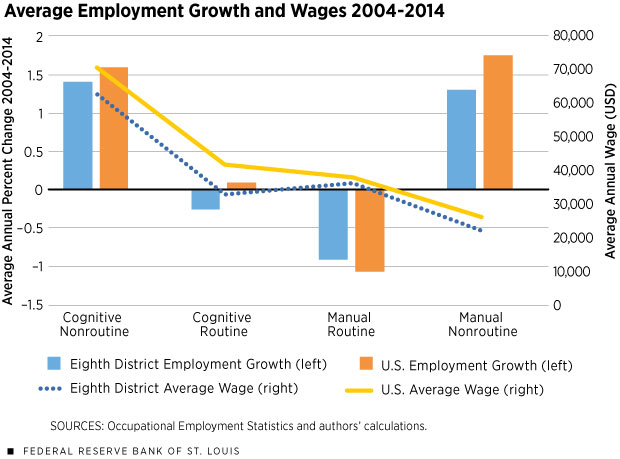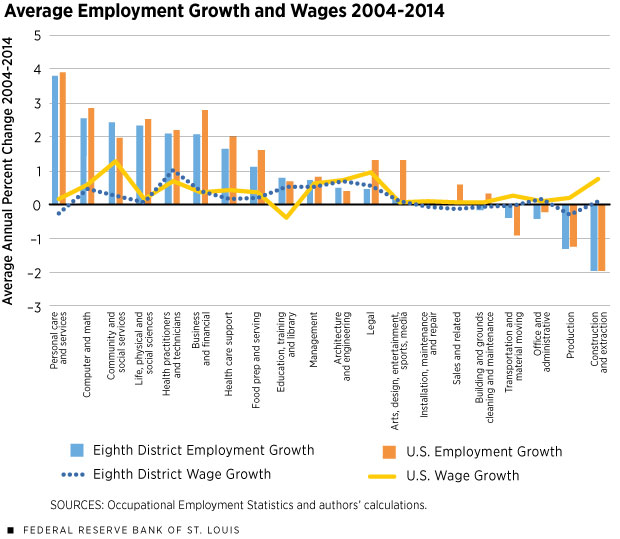Labor Market Polarization: How Does the District Compare with the Nation?
Over several decades, the U.S. labor market has been shifting away from jobs with routine tasks (e.g., manufacturing, construction and production) and toward those with nonroutine tasks (e.g., managerial, professional and service). Routine jobs tend to employ middle-skill workers, such as someone with a trade-school degree who might do electrical work. As routine employment declines, jobs are increasingly either low-skill (e.g., personal services or food preparation) or high-skill (management and professional occupations). This transition, called job polarization, is well-documented on the national level.1 In this essay, we examine the dynamics of occupational employment in the Eighth District since 2004 and compare them with national trends.
To identify the long-term trends in the District and nation, we divided the categories in the U.S. government’s 2010 Standard Occupational Classification into four groups: cognitive routine, cognitive nonroutine, manual routine and manual nonroutine.2 We assigned each occupation to a group based on the tasks typically performed by a worker in that occupation, similar to the process used in the Standard Occupational Classification.3 For example, managers and computer scientists would fall into the cognitive nonroutine category because their occupations draw from mental skills and involve adapting to the project at hand. Office and administrative staff fall into the cognitive routine category because their work involves repetitive tasks, although it is not physical. The manual routine group includes more jobs requiring physical labor, like those in manufacturing or construction. Lastly, the manual nonroutine group includes employees such as retail workers and personal-care associates who provide adaptive services based on the required task.
The data we used to track occupational wages and employment in the District and nation are in the Occupational Employment Statistics survey.4 The Bureau of Labor Statistics sends this survey out to about 200,000 businesses twice a year to gather statistics on employment and wages in very specific occupational categories. The data are available annually on the national and state levels from 1988 to 2014.
We used data from 2004 to 2014 for the nation and for states either entirely or partly covered by the Eighth District.5 Over that period, employment has increased in both the District and the nation. On average, the District has increased employment by 0.29 percent each year, while the nation has increased employment by 0.58 percent each year.
To identify job polarization trends in the District and the nation, we grouped occupations into the four categories outlined above. Figure 1 shows the average employment growth and wage levels in each category.6
In both the District and the nation, employment in nonroutine occupations, either cognitive or manual, grew the fastest. Employment in cognitive routine occupations grew at a very modest pace in the nation and declined in the District; manual routine occupational employment decreased in the nation and the District. This graph confirms that job polarization is as much an issue in the District as it is on the national level.
The lines on Figure 1 represent average real wages in 2014 dollars for each occupation group on the District and national levels. Routine occupations tend to be in the middle of the wage distribution. Cognitive nonroutine occupations have much higher wages, averaging well above $60,000 per year on the District and national levels, while manual nonroutine occupations typically have the lowest wages, paying less than $30,000 per year.
This wage difference highlights the polarization in the labor market, as employment grows the most at the polar opposites of the wage distribution.
Figure 2 breaks down the total employment growth numbers by occupation. Because the nation is growing slightly faster than the District, growth in the nation exceeds District growth in many of the occupational categories. The trends, however, are similar. In the District, occupations in personal services, computers and math, community and social services, and social sciences are experiencing the fastest job growth. The fastest-growing national occupations are more or less the same, with a few small differences. Business and financial occupations are growing faster in the nation than in the District, as are legal, arts and media, and sales occupations, among others. The three occupational groups growing faster in the District than in the nation are community and social service, architecture and engineering, and education, training and library occupations.
The occupations that are shrinking in the District are also shrinking at the national level. Transportation, office and administrative, production, and construction occupations all experienced declines in employment over the 10-year period. Office and administrative and production occupations are shrinking at a faster pace in the District than in the nation.
Figure 2 also shows the average annual real wage growth for these occupation groups. Similar to the employment growth patterns, wage growth in the District mirrors growth in the nation. Wage growth, however, appears to have no correlation with employment growth. The graph shows the occupations in order from fastest to slowest growth in the District. The wage line is mostly flat across the occupations, indicating no noticeable positive or negative relationship.
There are a few reasons why job polarization has occurred over the period studied. First, automation of routine and repetitive tasks decreases employment in routine occupations. As computers and technology advance, fewer repetitive-task jobs are available. Additionally, the increase in global connections allows some stages of the production process to be performed in foreign countries where labor is cheaper than in the U.S. This outsourcing also decreases employment in routine-task occupations.
Job polarization has been documented prominently on the national level. In this article, we identified that job polarization occurs in the Eighth District in the same way it does in the nation. Employment in routine-based occupations is declining, while employment in nonroutine occupations is increasing. This shift results in a wage gap between the highly paid cognitive nonroutine occupations and the low-paying manual nonroutine jobs. This shift may be an important driver of increasing income inequality in both the District and the nation.
Maximiliano Dvorkin is an economist, and Hannah Shell is a senior research associate, both at the Federal Reserve Bank of St. Louis. For more on Dvorkin’s work, see https://research.stlouisfed.org/econ/dvorkin.
Endnotes
- See, for example, Autor, Katz and Kearney (2006) and Autor and Dorn (2013). [back to text]
- The Standard Occupational Classification (SOC) system is a coding system designed by the federal government and used to classify workers into occupational groups for data collection and analysis. For more information, see www.bls.gov/SOC/. [back to text]
- See Foote and Ryan. We followed their classification of occupations into these large groups. [back to text]
- While the Occupational Employment Statistics Survey is a firm-level survey, the source data are different than the establishment (aka payrolls) survey. General trends between the two surveys are the same, but growth numbers may be slightly different. [back to text]
- We used data for the following Eighth District states: Arkansas, Indiana, Kentucky, Mississippi, Missouri and Tennessee. We excluded data from Illinois, a state that is partly in the Eighth District, because Chicago is the main driver of Illinois statistics and Chicago is outside the District. [back to text]
- Averages are weighted by total employment in 2004. [back to text]
References
Autor, David H.; and Dorn, David. “The Growth of Low-Skill Service Jobs and the Polarization of the U.S. Labor Market.” The American Economic Review, August 2013, Vol. 103, No. 5, pp. 1,553-97. See www.aeaweb.org/articles?id=10.1257/000282806777212620.
Foote, Christopher L.; and Ryan, Richard W. “Labor Market Polarization over the Business Cycle.” National Bureau of Economic Research Macro-economics Annual, 2015, Vol. 29, No. 1, pp. 371-413. See www.nber.org/papers/w21030.
Views expressed in Regional Economist are not necessarily those of the St. Louis Fed or Federal Reserve System.
For the latest insights from our economists and other St. Louis Fed experts, visit On the Economy and subscribe.
Email Us





